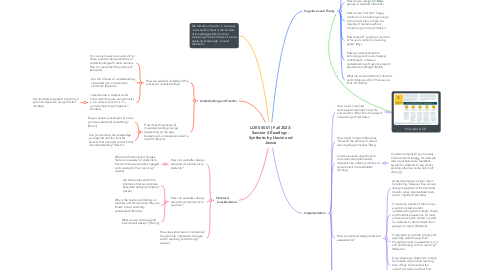
1. We talk about transfer in two ways - near and far. Near is the transfer of knowledge/skills to similar situations while far transfer is about applying knowledge in novel situations.
2. Understanding and Transfer
2.1. How can we best understand the process of understanding?
2.1.1. I’m curious how we can account for these nuanced demonstrations of understanding with adult learners. How do we collect this evidence? (Amanda)
2.1.2. Are the 6 facets of understanding organized into a hierarchical structure? (Melanie)
2.1.3. I wonder how a student could know when they are using transfer, is it a conscious act or is it a process that simply happens? (Andres)
2.1.3.1. Are teachers supposed to point out when students are using transfer? (Andres)
2.2. How does the process of misunderstanding change depending on the age, background, and experiences of a learner? (Hasini)
2.2.1. Do you have any examples of times you misunderstood something? (Hasini)
2.2.2. Can you recollect the knowledge you applied and the transfer process that occurred to reach that misunderstanding? (Hasini)
3. Structural Considerations
3.1. How can we better design educational institutions to students?
3.1.1. What are the structural changes that are necessary for students to become more personally engaged and invested in their learning? (Jessie)
3.2. How can we better design educational institutions to teachers?
3.2.1. Are there areas within the institution that can promote backward design principles? (Jessie)
3.2.2. Why is the burden still falling on teachers and faculty when they are known to be constantly overworked? (Andres)
3.2.3. What can we do to support instructional design? (Sicong)
3.3. How does structural or institutional change help implement changes within teaching and learning? (Jessie)
4. Cognitive Load Theory
4.1. If Cognitive Load Theory describes what happens on an individual level, can it still inform how we design for large groups of diverse learners? (Hasini)
4.1.1. Cognitive Load Theory emerged from experimental research on problem-solving involving many study participants. So, in other words, it is genelizable and can be treated as something that influences all individual learners as it focuses on cognitive architecture - working memory, long-term memory. The set of principles that emerged from that research is what helps us apply different strategies depending on the type of learning. an article that also might be helpful in relation to collaborative learning.
4.2. How can we design for large groups of students? (Andres)
4.3. How can we find that “happy medium” of introducing enough instructional tools to help the majority of learners without introducing too many? (Hasini)
4.4. How does CLT guide our decision to focus on content or learning goals? (Azy)
4.5. How can advancements in technology and neuroimaging contribute to a deeper understanding of cognitive load in educational settings? (Milos)
4.6. What are some additional criticisms and limitations of CLT that we can think of? (Milos)
5. Implementation
5.1. How could I use [new techniques/methods] in real life and would it differ from the project I’d working on? (Akmaral)
5.1.1. Principles of CLT
5.2. How might cultural differences influence the efficacy of varied learning design models? (Azy)
5.3. Could we use AI algorithms to recommend supplementary materials like videos or articles to complement the textbooks? (Sicong)
5.3.1. Could we employ AI as a memory enhancement strategy, for example add visual aids and a feedback system for students to see what's working effective and what's not? (Sicong)
5.4. How can we best design tests and assessments?
5.4.1. Assessment plays a major role in transferring, however, how can we design assessments that demand transfer when standardized tests are so important? (Andres)
5.4.2. It made me wonder if there is any way to truly test student understanding with multiple choice and true/false questions. Or must all exams be open ended in order for students to demonstrate their grasp on a topic? (Melanie)
5.4.3. If a student is not able to fully and explicitly work through their thought process in assessment, is it still contributing to their learning? (Melanie)
5.4.4. Does allowing a student to initially fail enable more robust learning than if they had reached the correct conclusion at their first attempt? (Melanie)
5.4.5. Would a failure without grades on the line be enough to provoke a student to evaluate the depth of their understanding of a subject? (Melanie)
5.5. Are students learning how to learn or just looking at the textbook? (Sicong)
5.5.1. What can we do to make this story easy for students to remember and connect back to what they learn? (Sicong)
